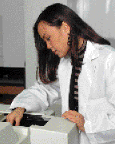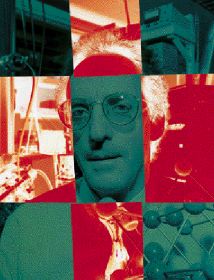By Jeff McClellan
When Matt Peterson talks about his colleague and mentor Morris Robins, he is animated and his speech is peppered with words such as excellent, great, and fantastic.
Peterson, a young assistant professor of chemistry, came to BYU almost two years ago and found himself with an office next to Robins, an internationally renowned chemist. During Peterson’s first semester, he and Robins taught a class together.
Peterson recalls a time when a student who was struggling came to talk to Robins. “Rather than saying, ‘You’ve got to work harder,’ he asked the student what was going on in his life,” he remembers. Peterson says Robins listened to get to the problem behind the problem; then he gave suggestions to help the student organize his personal affairs to maximize his academic performance.
“He’s a real builder,” says Peterson. “He builds students and is in the business of helping people grow.”
Robins, the 1996–97 Karl G. Maeser Distinguished Faculty Lecturer, is a builder in other ways as well. His colleagues in the Department of Chemistry and Biochemistry speak highly of Robins’ efforts to build and lift the department. And as a nucleoside chemist–some argue he’s the best in the world–his research and numerous discoveries over the past 30 years have built the general body of scientific knowledge and contributed to the fight against diseases such as AIDS, cancer, and hepatitis B.
Born in Nephi, Utah, Morris grew up in the nearby town of Scipio on a family farm, where his father’s example–and a long list of chores–taught him to work hard. In addition, his father’s natural curiosity and his mother’s college education encouraged the young Morris in his studies.
Robins took the long route from Scipio to Provo, stopping at the University of Utah, where his inherited curiosity kicked in and he majored in chemistry. Then he traveled to Arizona State University, New York, and back to the University of Utah before heading north to the University of Alberta at Edmonton. During 17 and a half years on the chemistry faculty in Alberta, Robins began his world travels as he became a regular lecturer at conferences and symposia. Then in 1987, he finally arrived at BYU.
It was during his PhD research at ASU that Robins dove into a rigorous research program that set the tone and direction for much of his career as he began to study nucleosides. Nucleic acids, such as DNA and RNA, make up genetic codes, and nucleosides are “the little guys that these gigantic genes are made of,” says Robins. The study of nucleosides is important because some diseases, such as AIDS and hepatitis B, actually alter a cell’s DNA. When the cell replicates, the disease can spread.
“If we can learn to understand nucleosides and deal with them, we can get them to do tricks that mess up the altered genes.” Through such nucleoside tricks, researchers hope to be able to inhibit these and other diseases.
Robins’ research with nucleosides has provided promising results. While at ASU, he became the first person in the world to synthesize two different nucleoside compounds. In the years since, one of those compounds was found to be an effective experimental anticancer agent, and a modification of the other–known as DDI–is one of the five approved nucleoside drugs used against AIDS. One of the compounds was also helpful in Frederick Sanger’s Nobel Prize–winning discovery of a method for sequencing genes.
Robins has done much work that has been built upon by others. But, he says, that’s the way science works.
“I’m really interested in basic curiosity-based research: Why do things happen? Why is nature this way? If you find answers to those questions, it provides the basis for beneficial things 10, 15, 20 years later. I invented DDI 15 years before AIDS was even recognized as a human disease. Nobody can plan that kind of thing.”
During the 30 years since he discovered DDI, Robins’ research successes have continued, and he has developed other compounds and methods that have been widely used. One such success is the result of a collaboration with Lorne Tyrrell at the University of Alberta Medical School. Based on one of the compounds Robins developed at ASU, the research has produced promising results for the treatment of hepatitis B.
All this work has produced more than 200 scientific papers, secured four patents, and initiated more than 60 speaking engagements.
“Morris Robins is recognized, by some people at least, as the best in the world, and by most people as one of the best,” says Professor Earl M. Woolley, the former chair of the Department of Chemistry and Biochemistry. “So people are after his opinion in granting agencies and workshops and international symposia.”
His colleagues credit his hard work, creativity, and thorough research with his success. Robins gives much of the credit to inspiration. “The Prophet Joseph Smith has indicated that at certain times pure knowledge flows, and I have experienced that a couple of times when all of a sudden–in just a matter of seconds–I understood things that would take hours to write down and that nobody else had discovered.”
Because he’s seen such success in his own efforts, Robins tries to lift and build his colleagues and the department. One way he’s helped the department is through a lecture series named after a former BYU chemistry professor, H. Smith Broadbent.
“He brings in a speaker once a year,” says department chair Francis Nordmeyer, “and these are all top-quality, well-respected, National Academy of Science members. It is not easy to get people like this to come for two days and give two lectures.”
Nordmeyer and Woolley stress the value of the lecture series to the department. By bringing in big names, Robins has increased the department’s credibility and reputation and has exposed students to some of the top researchers in the world.
Robins has helped build the department and university in many ways, and Woolley and Nordmeyer attest to his value as a citizen of the university community. But Nordmeyer says that helpful attitude is common in the department. Robins agrees: “I doubt the level of collegiality and cooperation and caring interaction in the Department of Chemistry and Biochemistry can be duplicated anywhere else in a department of this size.”
More than just collegiality, the department has produced more Karl G. Maeser Distinguished Faculty Lecturers than any other department on campus. Eight of the 36 recipients of the award have been chemistry professors.
While much of Robins’ international reputation is based on his research successes, the Maeser Lectureship is based on both research and teaching, areas Robins says complement each other. “What I learn in my research, I share in the classroom. Everything I do enhances everything else I do.”
With a reputation for being one of the most rigorous chemistry teachers with a tough grading scale, Robins teaches organic chemistry–often to pre-medical and pre-dental students who can be extremely competitive. Yet he continually gets high teaching marks from his students. During his six years as department chair, Woolley says he never had a student complain about Robins. “His colleagues are really kind of in awe of the fact that he can teach so rigorously and not have rebellion,” Woolley says. “It’s a real art to convince a class of that type of people that you’re on their side, and therefore you’re going to make them work hard and grade them conservatively.”
Peterson says Robins’ personality is a big factor in his relationships with students. “He has a charisma and kind of a charm that students like and warm up to. It’s not like he’s your stereotypical scientist that nobody can relate to because he’s off on some other planet thinking about his weighty theories.”
Robins says he enjoys his interaction with students. “What I really enjoy is seeing a student discover something and really understand it, whereas they didn’t even know it existed before.” His goal as a teacher is to help students learn, he says, but the responsibility to learn is theirs.
It is plain that Robins is a professor because he enjoys teaching and not for the research possibilities. “If you don’t like to teach,” he counsels other chemists, “go to a pharmaceutical company for twice as much money.”
Robins knows whereof he speaks. When he accepted the position to be a professor at the University of Alberta, he also had an offer from a research company for twice the salary he was offered at the university. He has continued to receive such tempting offers throughout his career, including while here at BYU.
“If I had wanted to make money, I would have been an investment banker and retired at a much earlier age,” he jokes.
But Woolley says it’s more than just money. “He’s sacrificing some of his professional recognition and all of that ego stuff–control and being in the midst of some big thing–to remain here.”
Ego, however, isn’t what drives Robins. Woolley and Nordmeyer point out that Robins doesn’t seek recognition or make noise about his accomplishments. He just goes on quietly about his work, happy to be a builder who helps others win Nobel Prizes and find cures for diseases.
For Robins, the enjoyable aspects of his job include working with humble, kind people on an international level. And when he talks about the most satisfying moments he’s had in his career, he mentions basic discoveries, the experiences where he sees, “Oh, this is the way it works!” And he tells a story of a physician at the University of Alberta Medical School who had cancer, but used the drug based on Robins’ compound and is now symptom free.
Peterson marvels at Robins’ humility and soft-spoken manner after having accomplished so much. “He holds very high standards in both scholarship and teaching,” Peterson says. “He shares these standards with his students and colleagues in a way that is both subtle and inspiring. Those who have eyes to see and ears to hear will pick up on it. He doesn’t beat you over the head with it, but his example is very much there and speaks volumes.”










